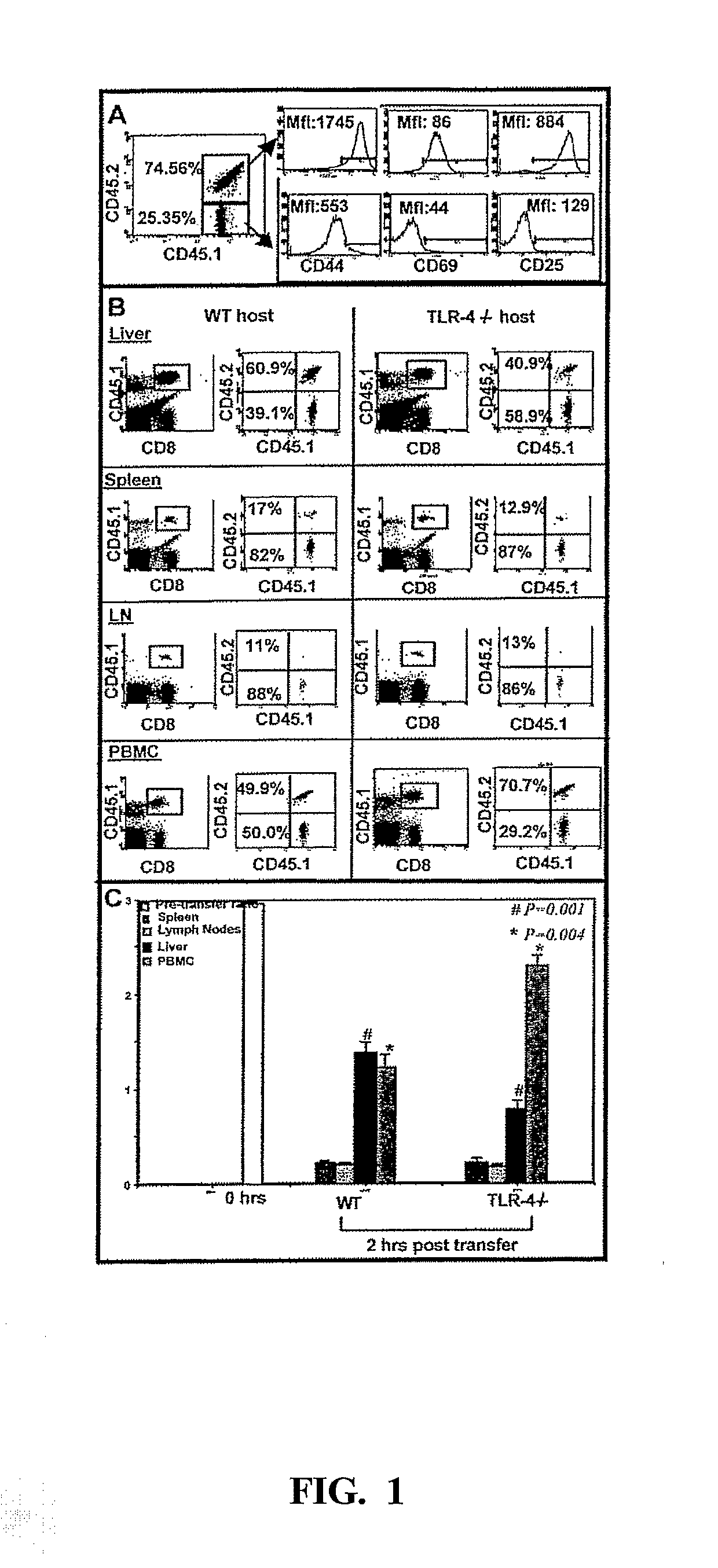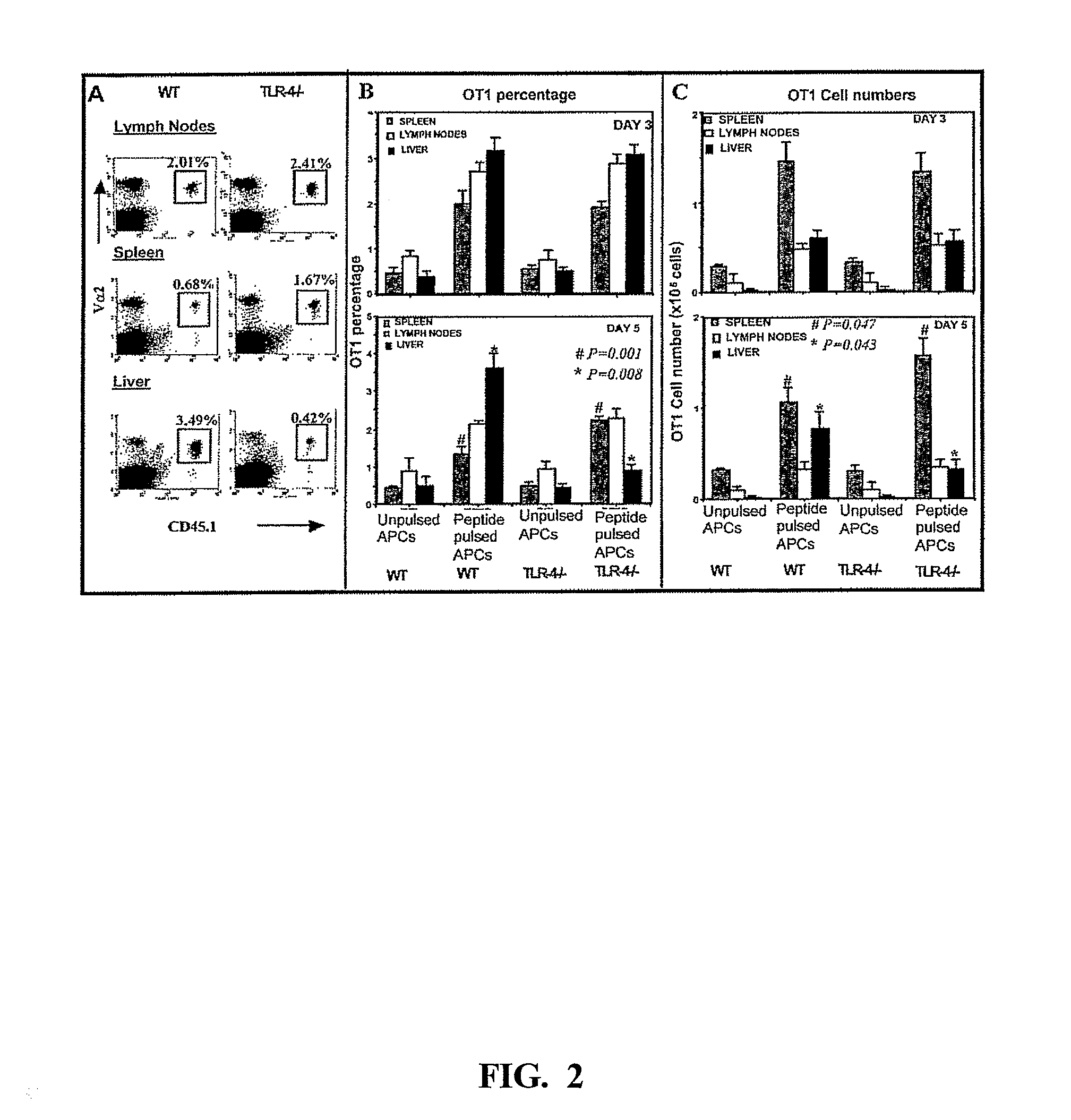Methods and compositions for enhancing immune memory by blocking intrahepatic activated t cell deletion
a technology of immune memory and t cell deletion, which is applied in the direction of snake antigen ingredients, peptide/protein ingredients, antibody medical ingredients, etc., can solve the problems of difficult to understand the maintenance of immune tolerance to harmless commensal bacteria, the effect of the migratory pattern of effector cd8+ t cells on their eventual fate is less well understood, etc., to enhance secondary immune response, and promote memory cell survival
- Summary
- Abstract
- Description
- Claims
- Application Information
AI Technical Summary
Benefits of technology
Problems solved by technology
Method used
Image
Examples
example 1
Liver is Defective in the Acute Trapping of Activated CD8+ T cells in the Absence of TLR-4
[0086]To test the role of TLR-4 in the accumulation of activated CD8+ T cells in the liver, a simple competitive trapping assay was developed to minimize any confounding effects of TLR-4 deficiency on CD8+ T cell activation or survival. In this assay, a mixture of activated and resting OT1 TCR transgenic CD8+ T cells was injected intravenously into either WT (C57 BL10 / SnJ) or TLR-4 deficient mice (C57BL10Scn), and located by FACS 2 hours later. The activated and resting cells were identified based on their expression of distinct allotypes of CD45. FIG. 1A shows the expression of activation markers on the two cell populations. The activated cells (CD45.1+45.2+) seen in the upper right quadrant, expressed higher levels of CD44, CD69 and CD25 compared to the resting cells (CD45.1+, 45.2−) seen in the lower right quadrant.
[0087]At 2 hours after T cell injection into normal mice (marked WT host), re...
example 2
In Vivo Activation of CD8+ T Cells in Wildtype and TLR-4 Deficient Mice
[0088]Testing the role of TLR-4 in the intrahepatic accumulation of CD8+ T cells activated in situ presents the problem that the TLR-4 deficient mice could be compromised in their ability to mount a normal immune response. Therefore, a model was developed in which normal OT1 TCR transgenic CD8+ T cells were transferred into either WT or TLR-4 deficient mice, and then primed in vivo using adoptively transferred spleen-derived dendritic cells from WT mice that had been pulsed in vitro with the specific antigenic peptide (SIINFEKL, SEQ ID NO:1). This model depends on direct priming, and the endogenous TLR-4 deficient APC are not involved (Wang et al., “Cutting Edge: CD4+ T Cell Help Can Be Essential For Primary CD8+ T Cell Responses in vivo,”J. Immunol. 171:6339-43 (2003), which is hereby incorporated by reference in its entirety). Using this model, equivalent clonal expansion of OT1 T cells was observed in the sple...
example 3
Activation of the OT1 Cells is Similar in Wildtype and TLR-4 Deficient Mice
[0089]To address the issue of whether the reduction in the OT1 cell numbers seen in the TLR-4 deficient livers was a result of differential activation, the responses in the two groups of mice was examined more closely. FIG. 3 shows that at three days after antigen exposure, the OT1 T cells were activated normally in TLR-4 deficient mice. Thus, the cells showed equivalent clonal expansion (for example, in the spleen from 0.60% to 1.69% of all lymphocytes in B6 mice, and from 0.55% to 1.44% in TLR-4 deficient mice), and this was also true in lymph nodes and the liver. The down-regulation of CD62L and up-regulation of CD44 also occurred identically in the B6 and the TLR-4 deficient hosts (FIG. 3). This was not surprising, since the T cells residing in both the WT and TLR-4− / − mice were activated with dendritic cells from WT mice. Such equivalent activation confirm the accuracy of the conclusions drawn from the o...
PUM
| Property | Measurement | Unit |
|---|---|---|
| Composition | aaaaa | aaaaa |
| Pharmaceutically acceptable | aaaaa | aaaaa |
| Immunogenicity | aaaaa | aaaaa |
Abstract
Description
Claims
Application Information
 Login to View More
Login to View More - R&D
- Intellectual Property
- Life Sciences
- Materials
- Tech Scout
- Unparalleled Data Quality
- Higher Quality Content
- 60% Fewer Hallucinations
Browse by: Latest US Patents, China's latest patents, Technical Efficacy Thesaurus, Application Domain, Technology Topic, Popular Technical Reports.
© 2025 PatSnap. All rights reserved.Legal|Privacy policy|Modern Slavery Act Transparency Statement|Sitemap|About US| Contact US: help@patsnap.com



